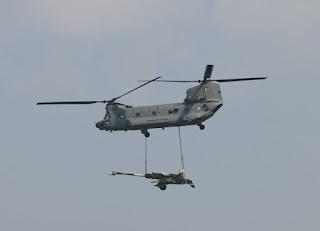Monday, October 11, 2021
336th Fighter Squadron deploys to Greece
F-15Es from the 336th Fighter Squadron have deployed to Greece from Seymour Johnson Air Force Base for exercise Castle Forge.
An F-15E Strike Eagle is prepped to take off at Seymour Johnson Air Force Base, North Carolina, Oct. 4, 2021. The 336th Fighter Squadron is deploying jets to Larissa Air Base, Greece, in support of operation Castle Forge, a U.S. Air Forces Europe-Air Forces Africa-led joint, multi-national training event designed to provide a dynamic, partnership-focused environment that raises the U.S. commitment to collective defense in the Black Sea region. (U.S. Air Force photo by Senior Airman David Lynn)
The APKWS is now capable of shooting down drones
Test rockets combined standard warheads and motors with APKWS guidance kits and a proximity fuze – enabling them to engage and destroy airborne drones at a fraction of the cost of traditional counter-UAS (C-UAS) strike capabilities.
BAE Systems, Inc. has successfully tested APKWS® laser-guided rockets in precision strike tests against Class 2 Unmanned Aerial Systems (UAS) at Yuma Proving Grounds. The 2.75” test rockets combined standard M151 warheads and Mk66 motors with APKWS precision guidance kits and a newly developed proximity fuze – enabling them to engage and destroy airborne drones at a fraction of the cost of traditional counter-UAS (C-UAS) strike capabilities.
“Unmanned Aerial Vehicles of all sizes are a growing threat increasingly deployed by adversaries around the globe,” said Greg Procopio, director of Precision Guidance and Sensing Systems at BAE Systems. “The flexibility and affordability of APKWS rockets make them a good choice for taking out small, tactical military drones. Our successful test strikes demonstrate the creativity of our engineers and an innovative and economical use of existing DoD materiel to address an emerging threat.”
BAE Systems conducted test fires and engineering tests to develop a capable system for U.S. armed forces and allies. The key to APKWS rockets’ counter-UAS capability is the innovative proximity fuze jointly developed by L3Harris Technologies and Technology Service Corporation. The fuze combines target proximity detection and point detonation capabilities, and is a drop-in replacement for existing M423 fuzes – allowing APKWS rockets to destroy UASs without the need for a direct hit.
Unlike expensive C-UAS missiles, APKWS rockets do not need to lock on the target before launch, instead relying on semi-active laser guidance optics that activate on launch, saving warfighters precious seconds when it counts.
APKWS guidance kits transform unguided rockets into precision-guided munitions with explosive effects and range capabilities that make them well-suited for today’s dynamic military engagements. APKWS rockets have proven combat capabilities and the flexibility to strike a variety of stationary and moving targets from planes, helicopters, ground vehicles, boats, and remote weapon stations.
JASDF F-2 loses canopy during scramble
A JASDF F-2 that scrambled from Tsuiki Airbase on Oct. 10 lost its canopy inflight while the jet was over the vicinity of Asakura city.
J-10 enters service with PLAAF Shijiazhuang Flight Academy
China announced recently that the Shijiazhuang Flight Academy has inducted the J-10 into service. The unit is in charge of training fighter and fighter-bomber pilots for the PLAAF.
Mistral 3 missiles for Jose Rizal class frigates have been delivered to Philippines
The Philippine Navy (PN) on Sunday said the Mistral 3 surface-to-air-missiles (SAMs) of the country's two guided-missile frigates were finally delivered at the Subic Bay International Airport in Bataan last Oct. 8.
In a statement, Navy spokesperson Commander Benjo Negranza said the surface-to-air missiles of the two Jose Rizal-class (JRC) frigates of the PN will provide the BRP Jose Rizal (FF-150) and BRP Antonio Luna (FF-151) anti-air capabilities or the ability to shoot down aerial threats.
Procurement and delivery of the Mistral 3 SAMs is part of the PN Frigate Acquisition Project Lot 2B which was awarded to MBDA Missile Systems based in France.
"Surface-to-air missiles are among the primary weapons of FF-150 and FF-151 that bolsters the PN’s anti-air warfare capability. The arrival of these missiles will greatly capacitate our JRC frigates in the conduct of their maritime operations," Negranza said.
Meanwhile, PN Frigate Acquisition Lot 2A or for the JRC's surface-to-surface missiles is scheduled for deliveries in March 2022.
South Korean defense manufacturer LIG Nex 1 is the company that would deliver C-Star missiles which is considered the main surface-to-surface weapon of the JRCs.
The C-Star is described as a "sea-skimming surface-to-surface anti-ship cruise missile".
The BRP Jose Rizal and BRP Antonio Luna are modern warships capable of surface, sub-surface, air, and electronic warfare using state-of-the-art electronic sensors, long-range missiles, acoustic guided torpedoes, and an embarked anti-submarine helicopter.
The BRP Jose Rizal was delivered to the Philippines in May 2020 and commissioned July of the same year while the BRP Antonio Luna was commissioned March 19, 2021.
The contract for the two ships was placed at PHP16 billion with another PHP2 billion for weapon systems and munitions. (PNA)
Sunday, October 10, 2021
JS Kaga and USS Carl Vinson to join exercise Malabar from Oct. 12-15
Phase 2 of exercise Malabar will commence from Oct. 12-15 in the Bay of
Bengal and USS Carl Vinson will join the exercise together with JS
Kaga.
-
The UK Ministry of Defence (MoD) has confirmed plans to temporarily replace two Bell helicopter types operated in Brunei and Cyprus with ...
-
The Dzhigit support launching unit (SLU) is designed for a single operator to mount, aim and launch two Igla or Igla-S MANPADS missiles in ...
-
USS Gerald R. Ford (CVN 78) had its first Air Intercept Control (AIC) event on Jul. 30 and the aircraft carrier’s crew directed F/A-18s from...







